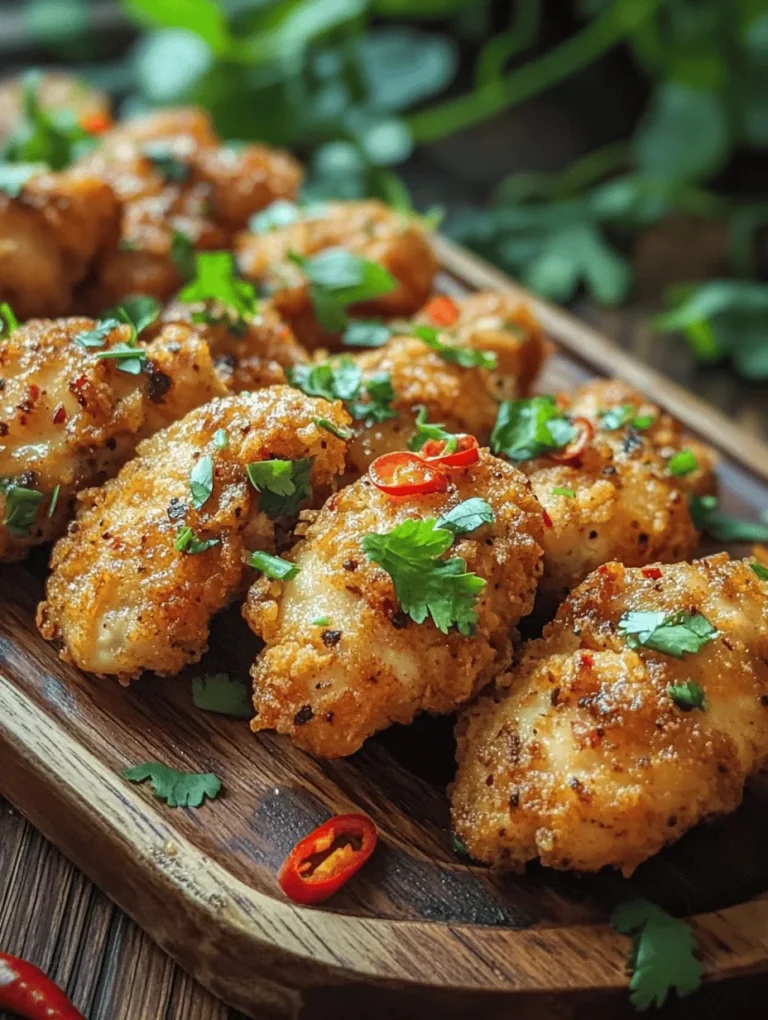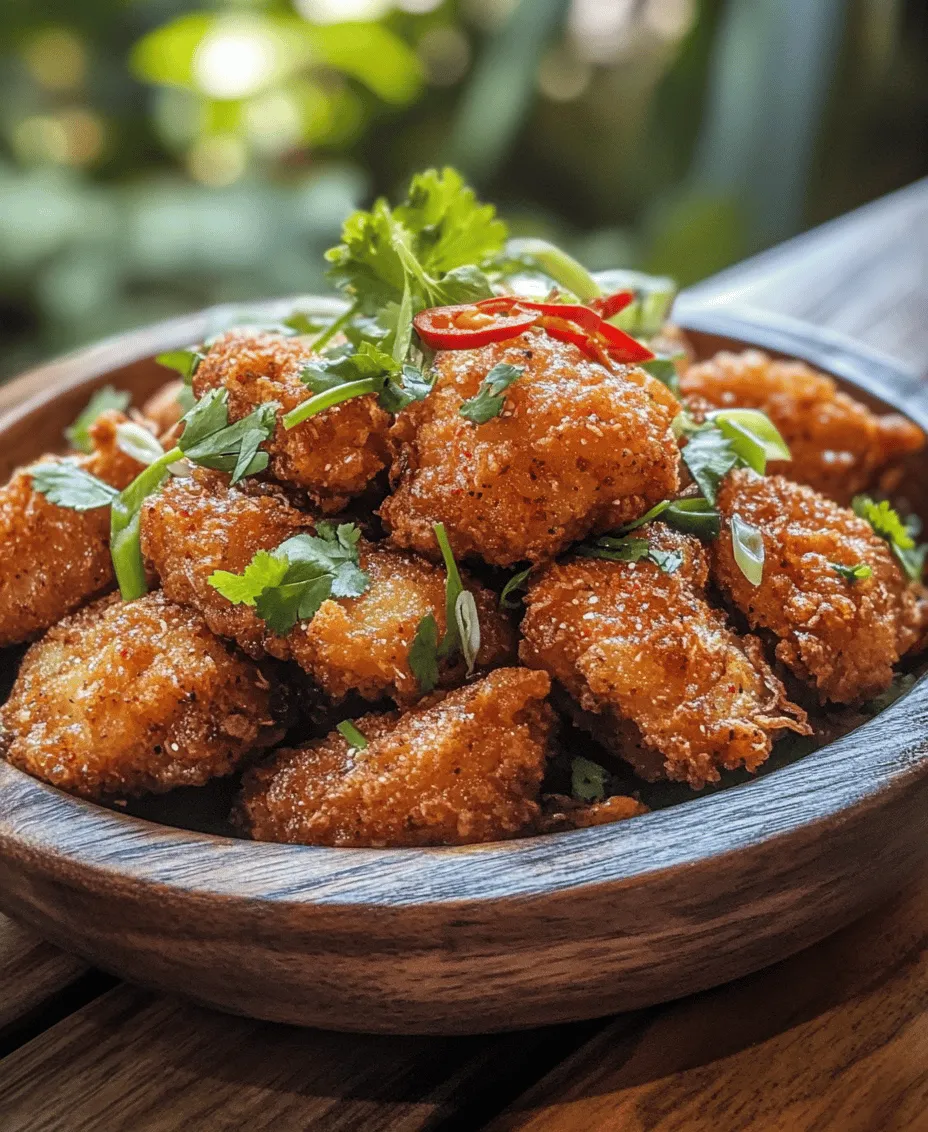Introduction
Salt and Pepper Chicken is a beloved dish that showcases the vibrant and diverse flavors of Asian cuisine. Known for its crispy coating and the bold, savory notes from the seasoning, this dish offers a delightful experience that tantalizes the taste buds. The combination of salty and spicy flavors, paired with the crunch of perfectly fried chicken, makes it a favorite among many. What sets this recipe apart is the addition of a zesty twist featuring Sichuan peppercorns, which elevate the dish with a unique flavor profile that is both fragrant and numbing.
In Asian cooking, the balance of flavors and textures is paramount. This dish exemplifies that principle, delivering a satisfying crunch, a savory depth, and a touch of heat, all harmoniously combined. The zesty twist not only enhances the traditional flavor but also introduces an exciting element that will leave your guests clamoring for more. Whether you’re hosting a dinner party or simply indulging in a comforting weeknight meal, Salt and Pepper Chicken with a Zesty Twist is sure to impress.
Understanding the Ingredients
To create the perfect Salt and Pepper Chicken, it is essential to understand the ingredients that contribute to its deliciousness. Each component plays a vital role in developing the flavors and textures that make this dish so appealing.
Chicken Thighs: Why They Are Preferred for This Dish
For this recipe, chicken thighs are the star of the show. Unlike chicken breasts, thighs contain a higher fat content, which makes them juicier and more flavorful. This richness helps to ensure that the chicken remains tender and moist even after frying. Additionally, the dark meat of the thighs stands up well to the bold flavors of the seasonings, making it an ideal choice for this dish.
Cornflour and Plain Flour: The Science Behind the Coating
The coating for the chicken is a crucial element in achieving that signature crunch. The combination of cornflour (cornstarch) and plain flour creates a light and crispy texture that is both satisfying and delightful. Cornflour helps to absorb moisture, resulting in a crispier finish, while plain flour provides structure to the coating. This blend not only enhances the mouthfeel but also allows the seasoning to adhere better to the chicken, ensuring that every bite is packed with flavor.
Sichuan Peppercorns: Their Flavor Profile and Cultural Significance
One of the standout ingredients in this recipe is Sichuan peppercorns. Unlike traditional black or white pepper, Sichuan peppercorns are not true peppercorns but rather the dried husks of the prickly ash tree. They impart a unique flavor that is citrusy and slightly floral, with a distinct numbing sensation on the palate. This unique characteristic adds complexity to the dish, setting it apart from other variations of salt and pepper chicken. In Chinese cuisine, Sichuan peppercorns are celebrated for their ability to elevate dishes, making them a beloved ingredient in various regional specialties.
The Role of Ginger, Garlic, and Chili in Enhancing the Dish
To further amplify the flavors in Salt and Pepper Chicken, fresh ginger, garlic, and chili peppers are incorporated into the recipe. Ginger adds warmth and a subtle spiciness, while garlic contributes an aromatic richness that complements the chicken beautifully. The addition of chili peppers introduces a kick of heat that balances the savory notes of the dish. Together, these ingredients create a symphony of flavors that make each bite an adventure.
Discussion on Ingredient Substitutions for Dietary Preferences
For those with dietary restrictions or preferences, there are several substitutions that can be made without compromising the dish’s integrity. To make this recipe gluten-free, you can replace plain flour with a gluten-free flour blend or additional cornflour. If you’re looking for a healthier option, you can also consider using skinless chicken thighs or even chicken breast for a leaner version. Additionally, for a plant-based alternative, tofu or tempeh can be used as a substitute for chicken, allowing everyone to enjoy this delicious dish.
Marinating the Chicken
Marinating the chicken is a crucial step that enhances its flavor and tenderness. The marination process allows the ingredients to penetrate the meat, infusing it with aromatic spices and creating a depth of flavor that will be evident in every bite.
Step-by-Step Explanation of the Marination Process
1. Prepare the Marinade: In a mixing bowl, combine soy sauce, sesame oil, minced ginger, minced garlic, and a sprinkle of salt and pepper. These ingredients work together to create a savory base that will enhance the chicken’s natural flavors.
2. Cut the Chicken: Trim any excess fat from the chicken thighs and cut them into bite-sized pieces. This will ensure that the chicken marinates evenly and cooks quickly.
3. Mix and Coat: Add the chicken pieces to the marinade, ensuring each piece is well-coated. Use your hands or a spatula to mix the chicken thoroughly with the marinade.
4. Marination Time: Cover the bowl with plastic wrap or transfer the chicken to a resealable plastic bag. Allow the chicken to marinate in the refrigerator for at least 30 minutes, or up to 2 hours for deeper flavor penetration. If time allows, marinating overnight is ideal for maximizing flavor.
Recommended Marination Time for Optimal Flavor
While a minimum of 30 minutes will impart some flavor, marinating for 1-2 hours is recommended for the best results. If you have the time, let the chicken soak in the marinade overnight. This extended marination allows the flavors to meld and ensures that the chicken is infused with a savory depth that will elevate the final dish.
Preparing the Coating
The coating is what transforms the marinated chicken into the crispy delight that everyone loves. Achieving the right texture requires attention to detail and a few key techniques.
Importance of the Coating in Achieving the Desired Texture
A well-executed coating is essential for achieving that desired crunch. The coating not only contributes to the texture but also acts as a barrier that locks in moisture, keeping the chicken juicy while it fries. A light, crispy coating creates a delightful contrast with the tender meat inside, making each bite irresistible.
Detailed Breakdown of the Coating Ingredients and Their Functions
The coating typically consists of a blend of cornflour and plain flour, seasoned with salt, pepper, and a hint of chili powder for an added kick. The cornflour provides the lightness needed for crispiness, while the plain flour adds structure. The seasoning enhances the overall flavor of the chicken, ensuring that the coating is just as delicious as the meat.
Tips for Achieving a Light and Crispy Texture
1. Dusting Technique: When coating the chicken, it’s important to shake off any excess flour before frying. This prevents the coating from becoming too thick and ensures that it crisps up properly.
2. Double Coating: For an even crispier finish, consider double coating the chicken. After the first coating, dip the chicken back into the marinade briefly and then coat it again in the flour mixture. This extra layer will result in a more satisfying crunch.
3. Fry Temperature: Ensure your oil is at the right frying temperature, around 350°F (175°C). If the oil is too hot, the coating may burn before the chicken cooks through; if it’s too cool, the coating will absorb excess oil and become soggy.
4. Batch Frying: Fry the chicken in small batches to avoid crowding the pan, which can lower the oil temperature and lead to uneven cooking. This technique will help achieve golden-brown, crispy chicken every time.
With these foundational steps in mind, you’re well on your way to mastering the art of Salt and Pepper Chicken with a Zesty Twist. The combination of marinated chicken, expertly crafted coating, and the unique addition of Sichuan peppercorns will surely make this dish a standout at any dining table.
Frying the Chicken
When it comes to frying chicken, achieving the perfect texture and flavor is paramount. The process involves not just the right ingredients but also the proper technique. Here’s how to ensure your salt and pepper chicken turns out perfectly crispy and flavorful.
Techniques for Frying Chicken to Perfection
Start by using a deep skillet or a large pot, ensuring that you have sufficient space to fry the chicken without overcrowding. This is crucial for achieving that golden-brown crust. The chicken should be coated in your seasoned flour mixture thoroughly, shaking off any excess. This ensures a crispy exterior that seals in moisture.
Importance of Oil Temperature and Frying in Batches
Oil temperature is critical in the frying process. Ideally, you want the oil to reach about 350°F to 375°F (175°C to 190°C). Use a kitchen thermometer to gauge this accurately. If the oil is too hot, the coating will burn before the chicken is cooked through. If it’s too cold, the chicken will absorb excess oil, resulting in greasy meat.
Fry your chicken in batches to maintain the oil temperature. Adding too many pieces at once will drop the oil’s heat, leading to uneven cooking. Fry each batch for about 8 to 10 minutes, turning occasionally until each piece reaches a deep golden brown.
Indicators of Doneness and How to Ensure Even Cooking
To check for doneness, insert a meat thermometer into the thickest part of the chicken. The internal temperature should reach at least 165°F (74°C). Additionally, the juices should run clear, not pink, when pierced. For even cooking, ensure the chicken pieces are similar in size, allowing them to cook uniformly.
Sautéing the Aromatics
Once your chicken is fried to perfection, it’s time to enhance its flavor profile with aromatic ingredients.
Role of Aromatics in Enhancing the Overall Flavor Profile
Aromatics like garlic, ginger, and chili not only add depth to the dish but also elevate the overall experience with their fragrant qualities. They will complement the crispy chicken beautifully, creating a dish that tantalizes the taste buds.
Tips for Sautéing Without Burning the Ingredients
To sauté without burning, use medium heat and be vigilant. Start by heating a tablespoon of oil in the same skillet you used to fry the chicken, scraping up any flavorful bits left behind. Add minced garlic and ginger first, stirring constantly for about 30 seconds until fragrant. Then, add sliced chili and chopped spring onions, continuing to stir for another minute. This method ensures that the aromatics cook evenly without burning, preserving their vibrant flavors.
How to Balance Flavors with the Addition of Spring Onions and Chili
Consider the heat level you prefer when adding chili. For a milder flavor, use fewer seeds or select a less spicy variety. Spring onions add a fresh crunch that balances the dish, so toss them in just before serving to retain their crispness. The key is to achieve a harmonious blend of flavors—spicy, savory, and aromatic.
Combining Flavors
With both components prepared, it’s time to bring everything together.
The Process of Integrating the Fried Chicken with Sautéed Aromatics
Once your aromatics are ready, add the fried chicken back into the skillet. Toss the chicken pieces gently to coat them with the aromatic mixture. This is where the magic happens—every bite will be infused with the warm spices and fragrant notes of garlic and ginger.
Importance of Tossing to Ensure Even Flavor Distribution
Tossing the chicken ensures that every piece is evenly coated with the aromatic blend. This step is crucial, as it allows the flavors to meld together seamlessly. You can also add a pinch of salt and freshly cracked black pepper at this stage to enhance the seasoning, but be careful not to overdo it, as the chicken already carries a good amount of seasoning from the flour.
Presentation Tips for an Appealing Dish
For a visually appealing dish, serve the chicken on a large plate or a platter. Garnish with additional spring onions and a sprinkle of sesame seeds for added texture. A side of fresh lime wedges adds a pop of color and a zesty note that balances the dish. Consider serving it with a vibrant salad or steamed rice to enhance the overall presentation.
Serving Suggestions
The beauty of salt and pepper chicken lies in its versatility.
Ideal Accompaniments for Salt and Pepper Chicken
For a complete meal, pair your chicken with steamed jasmine rice or fluffy quinoa. The neutral flavors of these grains absorb the aromatic sauces beautifully. Alternatively, serve it alongside a fresh garden salad or sautéed vegetables for a lighter option.
Suggestions for Serving as a Main Dish or Appetizer
This dish can shine as both a main course and an appetizer. For a dinner setting, serve it with a side of stir-fried greens or roasted Brussels sprouts. For a party or gathering, cut the chicken into smaller pieces, allowing guests to enjoy it as finger food. Accompany it with a dipping sauce, such as sweet chili or soy sauce mixed with a dash of vinegar, for an extra flavor kick.
Creative Serving Ideas to Elevate the Dining Experience
To elevate the dining experience further, consider serving the salt and pepper chicken in lettuce cups. This adds a crunchy texture and refreshing bite. You can also create a vibrant platter with colorful vegetables, offering a beautiful contrast to the golden chicken. For a fusion twist, serve the chicken in tacos with fresh pico de gallo and avocado, showcasing its adaptability.
Conclusion
Salt and pepper chicken with a zesty twist is more than just a meal; it’s a culinary experience that showcases the perfect balance of flavors and textures. The crispy chicken, combined with aromatic ingredients, creates a dish that is both satisfying and delightful.
This recipe is not only easy to prepare but also offers a versatile option for any occasion, whether a weeknight dinner or a festive gathering. We encourage you to try this recipe at home and discover how simple ingredients can come together to create something truly special.
Embrace the versatility of salt and pepper chicken, and experiment with your favorite sides and accompaniments. This dish finds its place in modern cooking, appealing to diverse palates and preferences. With each bite, you’ll appreciate the harmony of salty, peppery, and zesty flavors that make this dish a standout. Enjoy your cooking adventure!



